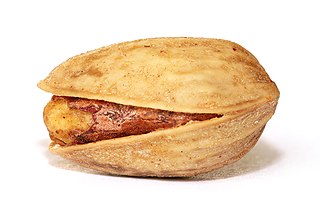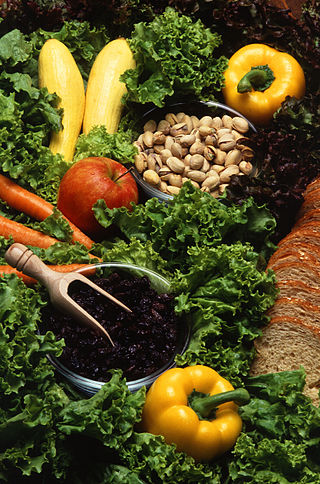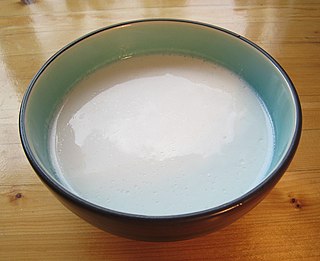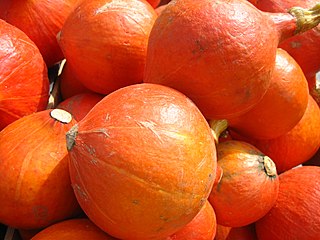
The pistachio, a member of the cashew family, is a small tree originating from an area that includes Afghanistan, Central Asia, and Iran. The tree produces seeds that are widely consumed as food.

The peanut, also known as the groundnut, goober (US), pindar (US) or monkey nut (UK), is a legume crop grown mainly for its edible seeds. It is widely grown in the tropics and subtropics, important to both small and large commercial producers. It is classified as both a grain legume and, due to its high oil content, an oil crop. World annual production of shelled peanuts was 44 million tonnes in 2016, led by China with 38% of the world total. Atypically among legume crop plants, peanut pods develop underground (geocarpy) rather than above ground. With this characteristic in mind, the botanist Carl Linnaeus gave peanuts the specific epithet hypogaea, which means "under the earth".

A nut is a fruit consisting of a hard or tough nutshell protecting a kernel which is usually edible. In general usage and in a culinary sense, a wide variety of dry seeds are called nuts, but in a botanical context "nut" implies that the shell does not open to release the seed (indehiscent).

Peanut butter is a food paste or spread made from ground, dry-roasted peanuts. It commonly contains additional ingredients that modify the taste or texture, such as salt, sweeteners, or emulsifiers. Consumed in many countries, it is the most commonly used of the nut butters, a group that also includes cashew butter and almond butter.

Special K is an American brand of breakfast cereal and meal bars manufactured by Kellogg's. The cereal was introduced to the United States in 1955. It is made primarily from grains such as lightly toasted rice, wheat and barley. Special K used to be marketed primarily as a low-fat cereal that can be eaten to help one lose weight.

Vegetarian nutrition is the set of health-related challenges and advantages of vegetarian diets.

Therapeutic foods are foods designed for specific, usually nutritional, therapeutic purposes as a form of dietary supplement. The primary examples of therapeutic foods are used for emergency feeding of malnourished children or to supplement the diets of persons with special nutrition requirements, such as the elderly.

Reese's Take 5 is a candy bar that was released by The Hershey Company in December 2004. The original name of the candy bar was TAKE5 but common usage among consumers added a space. In June 2019, when the candy bar became part of the Reese's family, the name was officially changed to Reese's Take 5.

A nut butter is a spreadable foodstuff made by grinding nuts into a paste. The result has a high fat content and can be spread like true butter, but is otherwise unrelated. Nut butters include:

Plant milk is a plant beverage with a color resembling that of milk. Plant milks are non-dairy beverages made from a water-based plant extract for flavoring and aroma. Plant milks are consumed as alternatives to dairy milk, and may provide a creamy mouthfeel.

A milk substitute is any substance that resembles milk and can be used in the same ways as milk. Such substances may be variously known as non-dairy beverage, nut milk, grain milk, legume milk, mock milk and alternative milk.
Peanut milk is a plant milk, which is an alternative to animal milk. It is made with peanuts, water, and sometimes other additional ingredients like salt, sugar, or cinnamon. Peanut milk is high in fat and protein compared to other plant-based milks. This milk is sometimes used by people who identify with lactose intolerance, veganism, or a casein-free diet, as it has no lactose, but includes nutritional benefits like being high in magnesium, Vitamin E, Vitamin B-6, and protein.

Crunchy Nut is a breakfast cereal made by Kellogg's with flakes of corn, honey, three types of sugar, and chopped peanuts. The product was created by Kellogg's employees at their Trafford Park factory in Greater Manchester and first introduced in 1980.
Hazelnut butter or hazelnut paste is a food spread made from crushed and blended hazelnuts. More commonly found in Europe, hazelnut butter is also familiar when mixed with chocolate as an ingredient in chocolate spreads. Hazelnut butter is available in both crunchy and smooth varieties, and can be made from either raw or roasted hazelnuts. Gianduja is also a type of chocolate stretched with hazelnut butter.

Equine nutrition is the feeding of horses, ponies, mules, donkeys, and other equines. Correct and balanced nutrition is a critical component of proper horse care.

Dipteryx alata is a large, undomesticated, edible nut-bearing tree from dryish tropical lowlands in central South America belonging to the legume family, Fabaceae, from the Dipterygeae tribe in the Faboideae subfamily. It is a wild species, widespread across the Cerrado savanna in South America. The baru nut seed is a grain legume, growing in popularity in North America as a snack food.

Red kuri squash is a thin skinned orange colored winter squash, a cultivated variety of the species Cucurbita maxima. It looks like a small pumpkin without the ridges. It belongs to the Hubbard squash group.

Peanut flour is made from crushed, fully or partly defatted peanuts. Peanut flour, depending on the quantity of fat removed, is highly protein-dense, providing up to 52.2 grams (1.84 oz) per 100 grams (3.5 oz). Culinary professionals use peanut flour as a thickener for soups, a flavor and aromatic enhancer in breads, pastries and main dishes.

Cashew butter is a food spread made from baked or roasted cashews. It is rich and creamy in flavour and when stored the oils and solids separate easily.
















